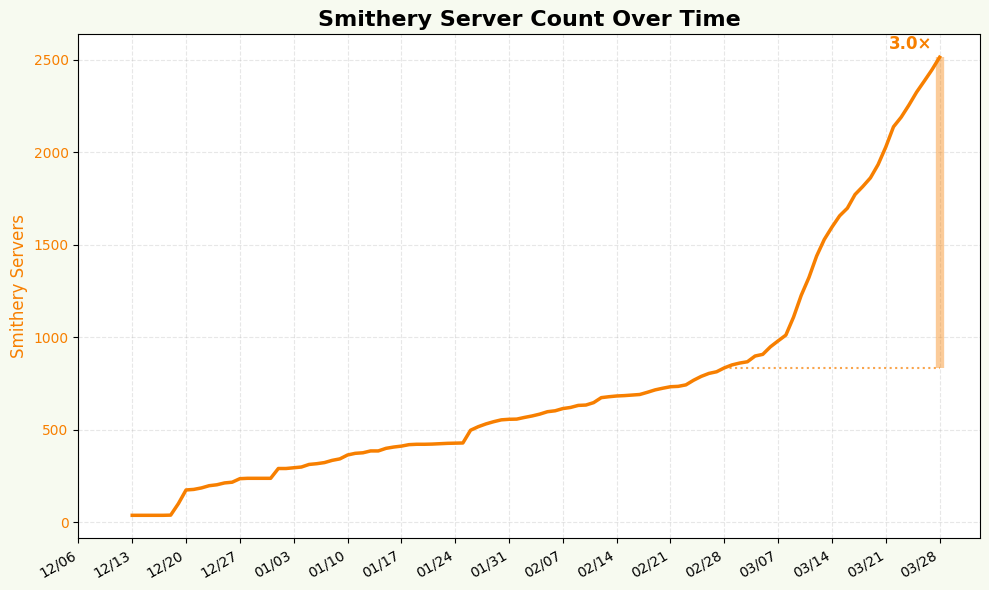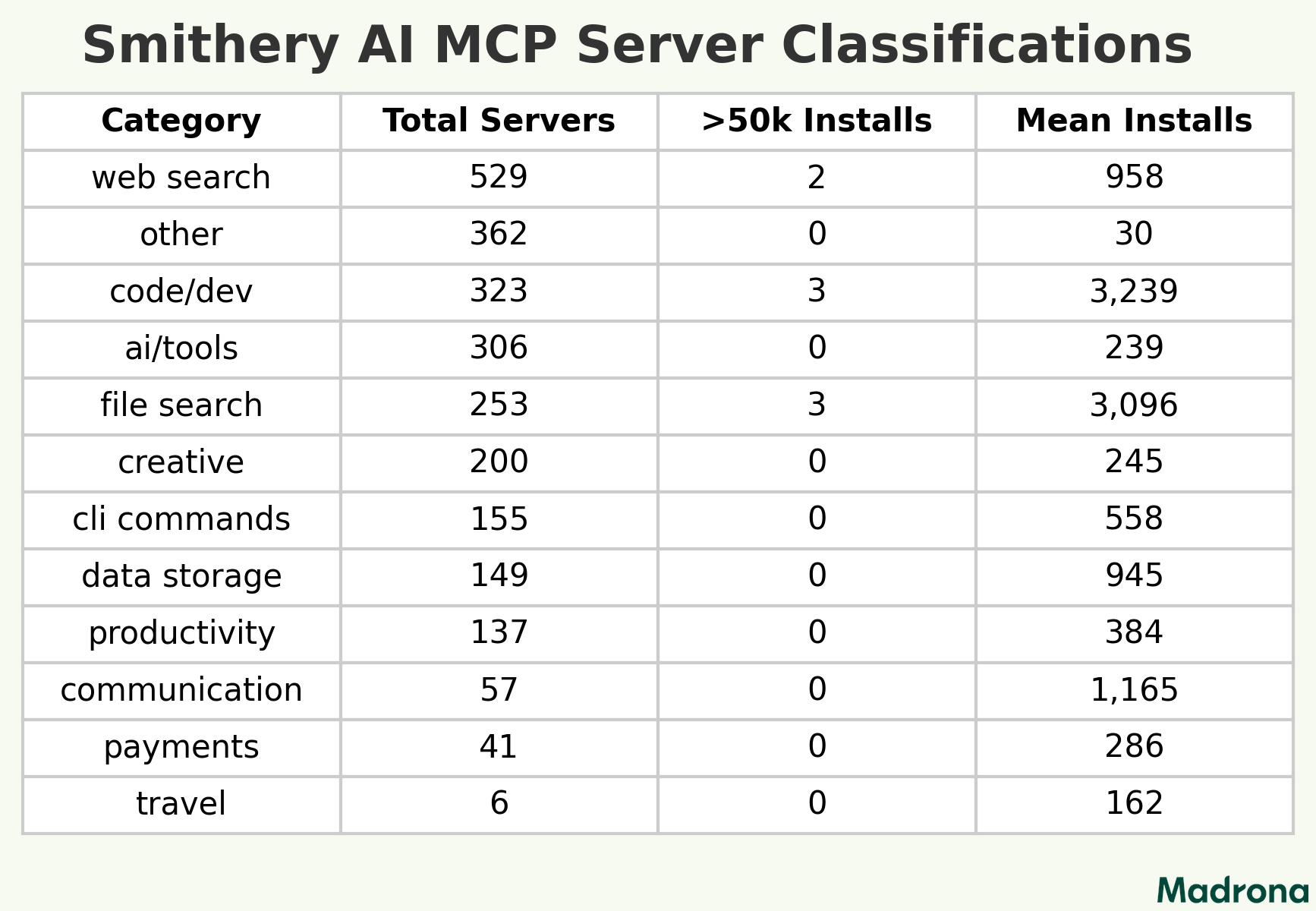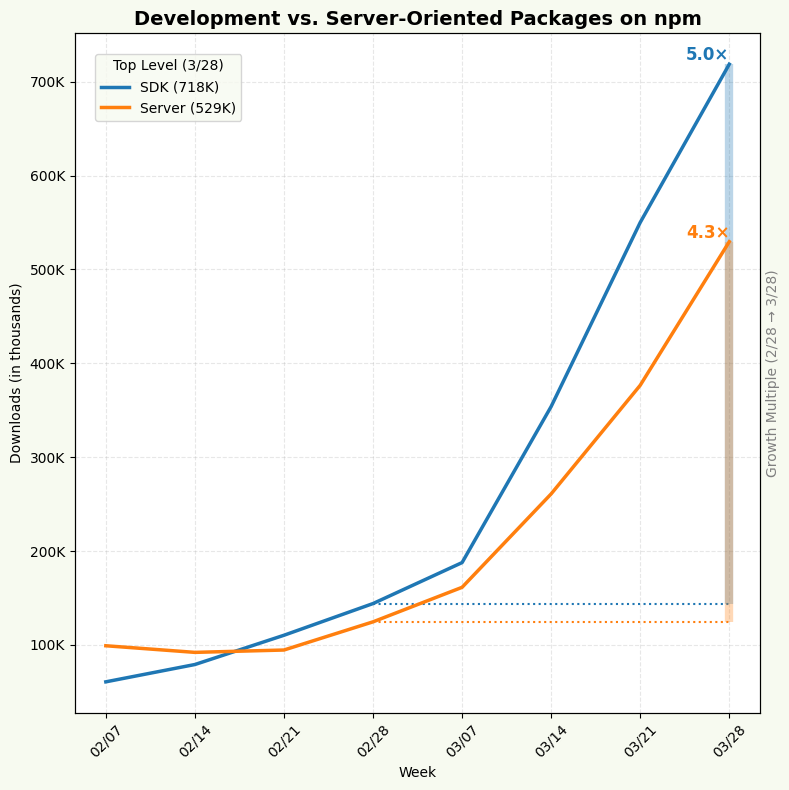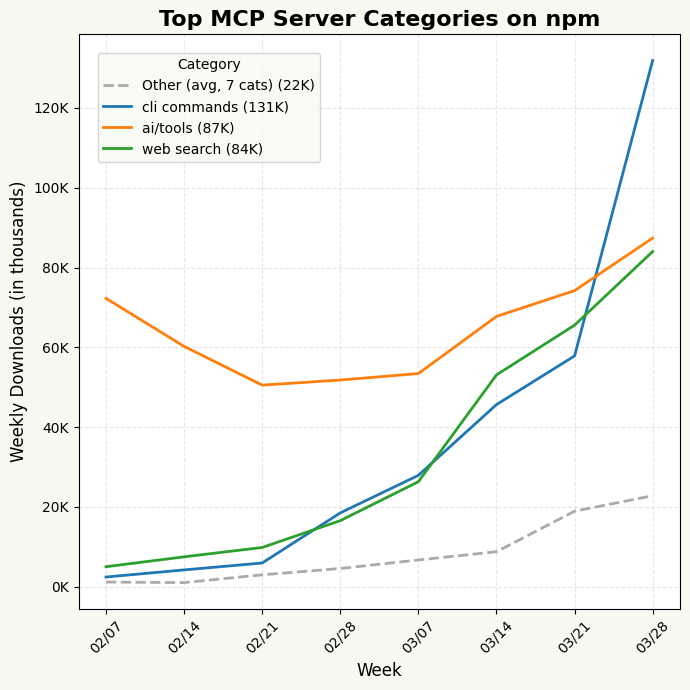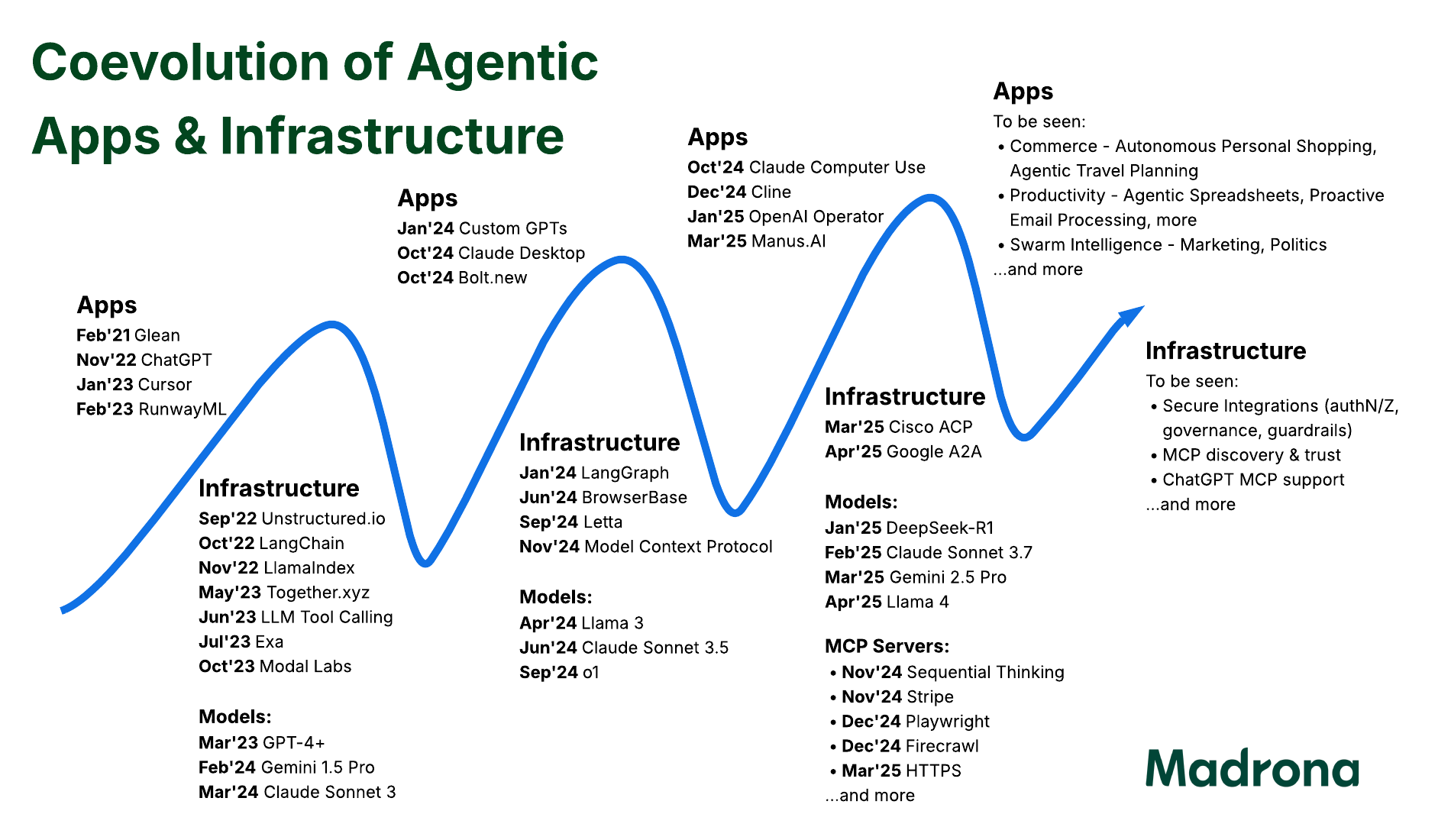- Model Context Protocol (MCP) expands agents’ functionality beyond chat by connecting to external services. It’s generating lots of excitement.
-
Nobody can know whether MCP will be the endgame winning standard or not. But MCP’s early traction shows a clear demand for extending agents’ functionality with a well-understood protocol.
-
The supply of MCP offerings is clearly outpacing demand today, with thousands of available servers but only a handful achieving meaningful adoption.
-
Digging into the data reveals a two-sided story: On one side, developer tools like Cursor are driving early MCP demand; on the other, the explosive growth in MCP server supply has created opportunities for founders to build experiences that weren’t previously possible.
Don’t let anyone tell you different: there is no such thing as a separate “infrastructure phase” in technology. The tech industry loves our neat narratives — first comes infrastructure, then applications follow. It’s tidy, linear, and completely wrong. Our research into the Model Context Protocol (MCP) ecosystem for expanding agents’ capabilities beyond chat provides fresh evidence of what’s actually happening: infrastructure and applications evolve simultaneously, each driving the other forward continuously.
Consider Coca-Cola, arguably one of the most successful “applications” in business history. You don’t need much infrastructure to formulate the drink itself. But without the development of industrial refrigeration, bottling technology, and modern transportation networks, Coca-Cola could never have become the global phenomenon it is today. Meanwhile, Coca-Cola’s massive success drove advances in those very infrastructure technologies.
Back to MCP – since Anthropic first released MCP in November 2024, its momentum has become undeniable: OpenAI now supports it. So do Amazon and Microsoft. Google announced an Agent2Agent (A2A) protocol, and Cisco announced an Agent Connect Protocol (ACP), both positioned as “complementary” to MCP, at least for now. GitHub stars for the MCP Server repo have surged past 25,000, with a gorgeously accelerating curve (see chart above).
But looking beneath these headline numbers helps understand what’s being built and used. We’ve analyzed data across MCP server directories and package repositories to reveal where we really stand in the ecosystem’s evolution — and what opportunities this creates for founders.
The Infrastructure-Application Interplay
Understanding the relationship between infrastructure and applications is crucial for making sense of the MCP ecosystem. Way back in 2018, Union Square Ventures wrote about “The Myth of the Infrastructure Phase” and illustrated how infrastructure and applications evolve in tandem:
New applications create demand for more sophisticated infrastructure, while advances in infrastructure enable entirely new categories of applications. This isn’t a sequential process but a continuous interplay where each side shapes the other.
We’re seeing this pattern unfold in real time with MCP. Take Arcade.dev, whose founders famously started out wanting to build an AI SRE. They quickly discovered it was difficult to bring their vision to life for lack of secure tool calling, so they pivoted to building that infrastructure instead. This isn’t a unique story — throughout tech history, application needs drive infrastructure development, and new infrastructure enables previously impossible applications.
The Problem MCP Solves
Before examining the data, it’s important to understand why MCP exists and what problem it solves. For most ambitious use cases, AI agents need to do more than just chat — they need to interact with external services to access real-time information, manipulate data, and take actions on behalf of users. These capabilities are what transform a conversational AI into a truly useful agent.
Traditionally, APIs have been the standard method for services to interact with each other. However, for AI agents, traditional APIs present significant challenges. They require precise parameter formatting, strict error handling protocols, and exact response parsing. The structured, deterministic nature of APIs clashes fundamentally with how AI models operate.
Early research projects like Toolformer and Gorilla demonstrated that large language models could learn to interact with APIs but revealed a fundamental mismatch: the probabilistic nature of AI models is poorly suited to the deterministic requirements of traditional APIs.
Traditional APIs require precise parameter formatting, error handling, and response parsing. AI models, with their probabilistic outputs, frequently hallucinate parameters, misunderstand response formats, or fail to properly handle errors. This made reliable tool use by AI agents nearly impossible at scale.
MCP solves this problem by providing a standardized way for AI models to discover what tools are available, understand how to use them correctly, and maintain conversation context while switching between different tools. It brings determinism and structure to agent-tool interactions, enabling reliable integration without custom code for each new tool.
To understand the difference this makes in practice, consider what happens when a user asks an AI assistant to “add a red button to my Figma design.”
Without MCP: The AI might attempt to generate code to call Figma’s API, but it could hallucinate parameters (“setColor(‘crimson’)” when the actual method is “setFillColor(‘#FF0000’)”), miss authentication steps, or fail to handle responses correctly. The result? Frustrated users and broken workflows.
With MCP: When Cursor connects to Figma’s MCP server, the AI knows exactly what methods are available, what parameters they require, and how to properly format requests. The Figma MCP server tells Cursor, “Here’s precisely how to add a red button,” and the action succeeds consistently. The user gets what they asked for without needing to understand the underlying technical details. This deterministic interaction is why MCP has generated so much excitement — it transforms unpredictable AI experiments into reliable production tools.
It’s not just a convenience — it’s a fundamental shift that makes AI agents practically usable in real-world scenarios. That is why there is so much excitement about it up and down the stack.
Where MCP Stands Today: The Data
Looking at the raw numbers, it’s clear that MCP’s explosive growth is driven primarily by the creation of new servers and development tools — what we might call the “supply side” of the ecosystem. These are the building blocks that developers make available for AI agents to use: search tools, API connectors, data access layers, and more.
The number of available MCP servers is growing rapidly. The official MCP typescript SDK is growing quickly and showing around 700K weekly downloads from npm. Smithery’s MCP discovery platform saw an explosive 3x growth in server creation during March alone.
But actual usage remains highly concentrated. Of Smithery’s 2,500+ MCP servers, only 8 have surpassed 50,000 installs. The distribution follows a classic power law:
Interestingly, while “web search” has the highest number of servers, “file search” and “code/dev” servers have much higher average installs per server — 3,096 and 3,239, respectively. This suggests that early users are technical builders looking for practical utility, not mass-market experiences. The categories seeing meaningful usage reveal a distinctly technical, developer-focused ecosystem.
- Web search (529 servers) and code/dev tools (323 servers) and lead in raw server counts, top installed servers include:
- Popular web search options include Brave Search, which integrates both web and local search, and Perplexity Search, which uses its Sonar Pro model for web queries.
- The most installed code/dev tools servers enable dynamic, reflective problem solving through structured thinking processes: Sequential Thinking and Think Tool.
- File Search tools have a high concentration of use with the second highest average installs (3,096) and 3 servers with more than 50k installs, notably:
- The Desktop Commander server is the second most installed server on Smithery’s platform; this server is used to execute terminal commands and manage files with diff editing capabilities.
- Communication tools have the third lowest count of servers at 57 but an outsized average install count of 1,165, the top servers in this category all work with the google suite:
- The VeyraX server is the most installed communication server, it works with 70+ tools most notably Gmail. The other top servers in the communication category focus on supporting Gmail management with four containing “google workspace” in their name.
We have also been tracking download activity of MCP server packages from npm that can be used directly with desktop hosts. We found 53 MCP SDK packages and 751 MCP server packages in the npm ecosystem. SDK downloads are growing significantly faster than server downloads, pointing to a supply-led dynamic. Developers are preparing for use cases that haven’t yet materialized.
The “AI/tools” category leads in raw volume with 156 servers published and an impressive average of >10,000 installs each. But, when it comes to per-server traction, some smaller categories are punching well above their weight. “File search” has just 13 servers — but with an average of 20,000 installs, these tools are delivering real value to agentic workflows. Similarly, “CLI command” packages quietly dominate download counts: only 39 exist, yet their mean installs exceed those of the more popular categories.
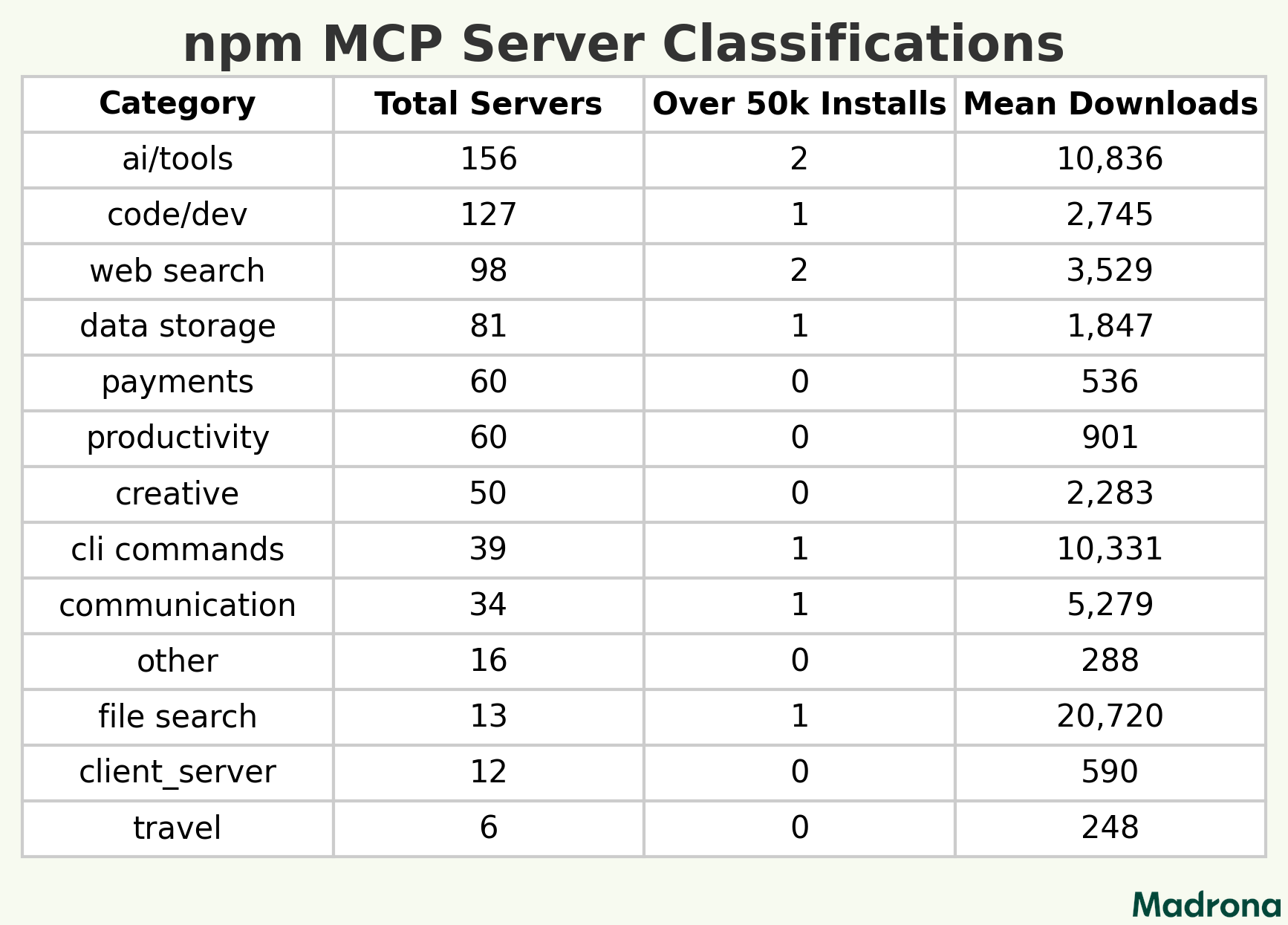
The npm weekly download data reveals interesting categorical trends as well. “CLI commands” leads with 131K total downloads (with the Smithery-CLI – used for installing packages from that platform – accounting for the majority). “AI/tools” and “web search” follow with 87K and 84K downloads, respectively, though “AI/tools” shows a plateau while “web search” maintains steady growth.
Overall, the install data reflects a developer base that’s deeply technical and still in the experimental phase. We’re seeing developers working at an extremely low level, indicative of very early experimentation rather than the more abstracted usage patterns we’d expect for mature, imaginative applications. Demand today is concentrated on primitive building blocks like search tools and command-line utilities — basic capabilities that form the foundation for more sophisticated workflows down the road.
Patterns Emerging: Where Supply Meets Demand
Let’s make sense of the mismatches and inconsistencies across supply and demand that our data reveals:
- Applications are driving infrastructure priorities: Today’s demand is mostly for desktop applications and single-user scenarios. Cursor, a code-focused AI assistant, has emerged as a major source of MCP demand, which tracks with the developer-focused tools seeing the most traction.As users request capabilities in their applications, they create demand for new types of infrastructure. If ChatGPT and/or Operator introduces MCP support for example, that might provide a strong foundation for a new set of multi-user agent apps.
- Infrastructure concentration is enabling new applications: The traction we’re seeing in reasoning tools (like Smithery’s “Sequential Thinking”) and web/UI automation suggests infrastructure is consolidating around capabilities that will enable more sophisticated agent applications.The popularity of Smithery’s Sequential Thinking server isn’t accidental—it addresses the fundamental problem we outlined earlier. Rather than expecting AI models to learn API usage patterns probabilistically (as Toolformer attempted), it encodes structured reasoning directly into the tool, making interactions more deterministic and reliable. This pattern suggests future successful tools will similarly encode knowledge and structure rather than relying on AI models to figure it out themselves.
This isn’t a story of “infrastructure phase” versus “application phase” — it’s about the ongoing interplay between the two just as Union Square Ventures described in 2018. The supply of MCP servers is responding to early application needs while simultaneously creating new possibilities for application developers.
Opportunities for Founders Up and Down the Stack
Based on our research, we see distinct opportunities on both sides of this interplay:
For Infrastructure & Tool Providers
If you’re building or enhancing tools and services that agents can leverage, the data points to three clear imperatives:
Get started with MCP, but don’t put all your eggs in one basket. As we’ve seen, the new form factor of AI agents requires more than traditional APIs to function reliably. The excitement around MCP is happening because it addresses the fundamental mismatch between probabilistic AI models and deterministic API requirements. MCP servers are a good answer today for helping developers to integrate reliably with your service, versus choosing to integrate something else. But the future of these protocols remains unwritten. As one infrastructure provider candidly told us, developers today are ‘stuck with an underdeveloped framework that hasn’t reached maturity.’ Consider building with MCP but maintain flexibility to adapt as the standard evolves.”
Mind the gaps that impede development. A few key issues hold back broader MCP adoption. Security and governance top the list, especially for enterprise use cases that demand strong permissions, auditability, and risk controls. Discovery and authentication (AuthN/AuthZ) also create friction, with a fragmented landscape making multi-service workflows harder than they should be. Trust is also a concern: with thousands of MCP servers live, developers and agents need better ways to identify reliable tools and weed out bad actors. And malicious actors aside, missing guardrails mean that (say) your IDE might attempt to delete critical files when it shouldn’t.
Composition and collaboration are other gaps in today’s environment. The most powerful agent applications require tools that can themselves leverage other tools—including calling LLMs or other services during execution. The current MCP specification doesn’t easily support this level of composition, limiting the sophistication of what developers can build on MCP.
Founders can address these gaps by contributing to extend MCP, embracing some of the functionality in Google A2A or Cisco ACP, or by building their own solutions. Those who find the right formula to address these gaps won’t just improve their products — they’ll move the entire ecosystem forward.
Be responsive to real-world agent development needs. The most successful infrastructure providers will be the ones who closely observe what agents users are actually trying to build, then evolving their offerings to address the specific pain points they encounter. This responsiveness, more than any particular feature, will determine which infrastructure providers thrive.
For Agent Developers
The opportunity here is transformative. AI agents represent an entirely new form factor of application, and the entire universe of software is up for grabs. Just as mobile created an opportunity to rebuild every application for a new form factor, agents create a similar opportunity at an even larger scale.
The MCP supply rush documented in our research has created more powerful tools than ever before. The question isn’t what tools exist but what you can now accomplish that was previously impractical or impossible by taking advantage of this expanding toolkit.
Our data shows that even with limited adoption today, tools for reasoning, web interaction, data access, and communication are rapidly maturing. This means agent developers can focus on delivering value through composition and orchestration rather than building core capabilities from scratch.
The data suggests several underserved categories that may represent opportunities, including productivity tools, analytics capabilities, commerce solutions, and travel services. But rather than chasing categories, the broader message is to find a customer problem you’re passionate about that is newly practical to solve with the expanding capabilities of MCP and the agent stack.
MCP is still a nascent technology with significant limitations, such as the ones we named above around authentication, discovery, and security. But it highlights an unmistakable trend toward agents that expand their capabilities far beyond chat. And so app developers should consider what is now possible/practical for the first time due to the infrastructure that is coming available. Don’t let the technical enthusiasm overshadow what really matters—making customers happy and helping them get agents into production that solve real problems.
Looking Forward: Accelerating the Cycle
The MCP ecosystem follows a familiar pattern but with a crucial difference: the compressed timeline of AI advancement means the infrastructure-application interplay is occurring faster than ever.
To be sure, anything can happen to MCP, notwithstanding the amazing early excitement around it. History is littered with examples of protocols like OpenStack that launched to great excitement and ran out of steam. And MCP “complements” such as Google A2A and Cisco ACP could expand to become full-fledged alternatives in the future. Those specifics don’t matter, though, as much as the clear demand by agent app developers for infrastructure that extends their agents’ capabilities beyond chat. Founders who can identify previously intractable problems that are now solvable will build the next generation of defining applications.
Remember Coca-Cola? It took decades for industrial refrigeration to mature enough for mass distribution of cold beverages. The relationship between Coca-Cola’s product innovation and infrastructure development unfolded over generations. In the AI agent world, we’re seeing similar patterns of interplay but on a timeline measured in months rather than decades.
Unlike the slow evolution of industrial infrastructure or even the years-long maturation of mobile apps (iOS App Store launched in 2008, but Uber and Airbnb arrived only in 2010), we’re seeing daily and weekly shifts in what’s possible with agents. The builders that position themselves now to ride this wave of interplay — whether building infrastructure or applications — will define the next generation of AI-powered software.
Madrona is actively investing in founders shaping both sides of this evolving ecosystem — up and down the stack. If you’re building in this space, we’d love to hear from you at [email protected].


